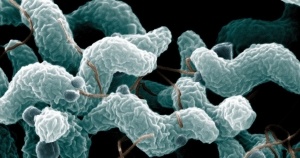
Campylobacter jejuni, a leading culprit in causing stomach upset, by De Wood, Pooley, USDA, ARS, EMU. [Public domain], via Wikimedia Commons [1].
Evolution News and Science Today [2]
Excerpts:
In my new book, Foresight: How the Chemistry of Life Reveals Planning and Purpose [3], I argue that the synergistic action of diarrhea and the appendix provides a strong case for foresight and thus for intelligent design.
Jerry Coyne, writing at Why Evolution Is True, has responded. For that I am grateful. See, “ID craziness: Diarrhea and the appendix are signs of intelligent design [4].”
I wish, enthusiastically, to reply. The subject under discussion is so-called vestigial organs [5], specifically the appendix. For decades we were told that — due to evolution — our body includes organs that have lost their functions and are therefore in the process of being eliminated.
Dr. Coyne adds that some of those condemned organs, by accidently finding other functions, may get lucky enough to escape extinction. This is possible, I agree. The “vestigial organs” are taken as strong evidence for evolution and against ID. After all, an intelligent designer would have no use for useless organs. With that I also agree.
However, we must let the data speak [6]. When we do, learning more about the physiology of our body, we find that “vestigial organs” have amazing functions after all.
Let the Data Speak
The appendix, for example, performs not just a single function, but several [7]. However, for Coyne and most Darwinists, there is no such thing as bad news. If a previously “functionless” organ like the appendix is discovered to have functions after all, one may always say that it escaped extinction by finding these new functions, thus providing adaptive “advantages.” Nothing, it seems, is more endlessly adaptable than the theory of evolution.
Meanwhile the number of vestigial organs continues to shrink. Once they were listed at 86 or more [8]. Now they are down to just a few. Dr. Coyne says there are “many vestigial features that have no known function at all,” but for humans he cites only “the muscles in human ears that can move them about.” He also mentions “snake limbs.”
Regarding the appendix and diarrhea, he writes:
Let’s see if there’s good evidence for design here. First of all, diarrhea may well be a body’s way of flushing out toxic substances and microbes from the gut. There’s no problem with that evolving by natural selection, and this has been recognized by advocates of Darwinian medicine for a long time… [T]here’s no barrier to seeing how a body’s expulsion of noxious substances could have been adaptive….
It’s entirely possible, for instance, that features of the gut causing diarrhea evolved as an adaptive response to toxins and bad microbes.
Is this indeed “entirely possible” or more like wishful thinking? I agree that diarrhea can indeed be beneficial and “adaptive.” But the problem with this interpretation is quite obvious.
Diarrhea only provides an adaptive advantage when perfectly tuned with the digestive system!
If Dr. Coyne had described a little of the physiology and biochemistry of diarrhea [9], his readers would have been able to appreciate how beautiful and mind-boggling it is.
First, in our intestines, there are the mechanisms for absorbing and secreting water and electrolytes (minerals in the body that carry an electric charge).
These processes are so finely balanced and dynamic that their operation requires a myriad of individual cell membrane transporters, electrolyte-secreting organs, highly selective and specialized membrane proteins, and more.
The system is so intricate that the author of a review on the physiology of diarrhea [10] throws up his hands at the complexity of it all: “Attempting to outline the complex, multifaceted relationships among epithelial ion-transporting cells, epithelial endocrine cells, mesenchymal cells (fibroblasts, mast cells, neutrophils, T and B lymphocytes, eosinophils, etc.), and nerves is beyond the scope of this review.” The author provides a whole table with many entries just for the reader to “glean some of the complexity.”
It has been said that evolution hopes we don’t know chemistry. I would add that it hopes we don’t know physiology, either.
Read the full article at Evolution News and Science Today [2]
